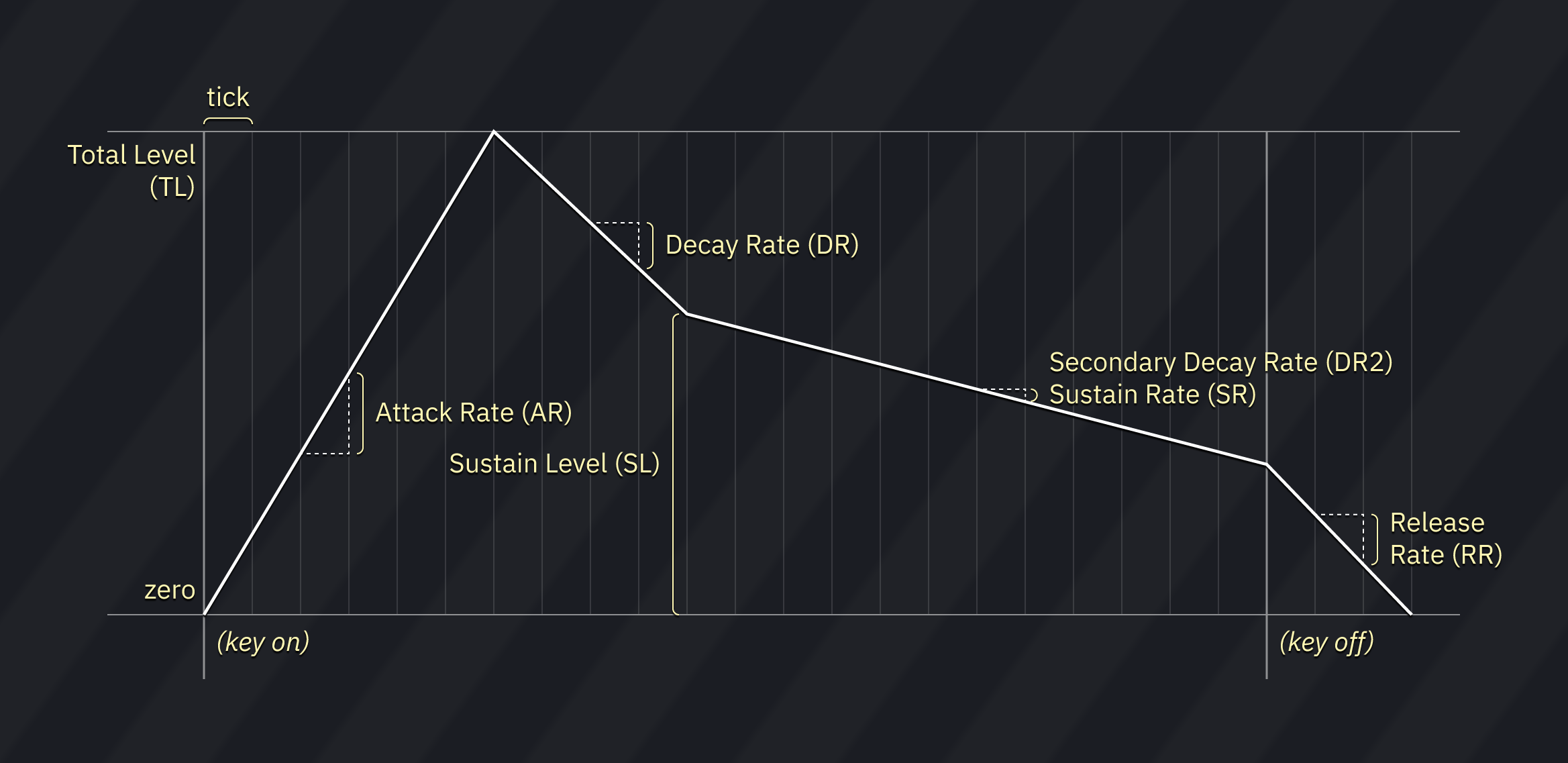mirror of
https://github.com/tildearrow/furnace.git
synced 2024-11-27 06:53:01 +00:00
4 KiB
4 KiB
FM synthesis instrument editor
The FM editor is divided into 7 tabs:
- FM: for controlling the basic parameters of FM sound source.
- Macros (FM): for macros controlling algorithm, feedback and LFO
- Macros (OP1): for macros controlling FM parameters of operator 1
- Macros (OP2): for macros controlling FM parameters of operator 2
- Macros (OP3): for macros controlling FM parameters of operator 3
- Macros (OP4): for macros controlling FM parameters of operator 4
- Macros: for miscellaneous macros controlling volume, arpeggio, and YM2151 noise generator.
FM
The FM synthesizers Furnace supports are four-operator, meaning it takes four oscillators to produce a single sound. Each operator is controlled by several sliders.
- Attack Rate (AR): determines the rising time for the sound. The bigger the value, the faster the attack. (0-31 range)
- Decay Rate (DR): Determines the diminishing time for the sound. The higher the value, the shorter the decay. It's the initial amplitude decay rate. (0-31 range)
- Secondary Decay Rate (DR2) / Sustain Rate (SR): Determines the diminishing time for the sound. The higher the value, the shorter the decay. This is the long "tail" of the sound that continues as long as the key is depressed. (0-31 range)
- Release Rate (RR): Determines the rate at which the sound disappears after KEY-OFF. The higher the value, the shorter the release. (0-15 range)
- Sustain Level (SL): Determines the point at which the sound ceases to decay and changes to a sound having a constant level. The sustain level is expressed as a fraction of the maximum level. (0-15 range)
- Total Level (TL): Represents the envelope’s highest amplitude, with 0 being the largest and 127 (decimal) the smallest. A change of one unit is about 0.75 dB.
- Envelope Scale (KSR): A parameter that determines the degree to which the envelope execution speed increases according to the pitch. (0-3 range)
- Frequency Multiplier (MULT): Determines the operator frequency in relation to the pitch. (0-15 range)
- Fine Detune (DT): Shifts the pitch a little (0-7 range)
- Coarse Detune (DT2): Shifts the pitch by tens of cents (0-3 range) YM2151 sound source only.
- Hardware Envelope Generator (SSG-EG): Executes the built-in envelope, inherited from AY-3-8910 PSG. Speed of execution is controlled via Decay Rate. YM2610/YM2612 sound source only.
- Algorithm (AL): Determines how operators are connected to each other. (0-7 range)
- Feedback (FB): Determines the amount of signal whick operator 1 returns to itself. (0-7 range)
- Amplitude Modulation (AM): Makes the operator affected by LFO.
- LFO Frequency Sensitivity: Determines the amount of LFO frequency changes. (0-7 range)
- LFO Amplitude Sensitivity (AM): Determines the amount of LFO frequency changes. (0-3 range)
Right-clicking on the algorithm view switches to a preview display of the waveform generated on a new note:
- Left-click restarts the sound.
- Middle-click pauses and unpauses the preview.
- Right-click returns to algorithm view.
Macros
Macros define the sequence of values passed to the given parameter. Via macro, aside previously mentioned parameters, the following can be controlled:
- LFO Frequency
- LFO Waveform: YM2151 sound source only.
- Amplitude Modulation Depth: YM2151 sound source only.
- Frequency Modulation Depth: YM2151 sound source only.
- Arpeggio Macro: Pitch change sequence in semitones. Two modes are available:
- Absolute (default): Executes the pitch with absolute change based on the pitch of the actual note.
- Fixed: Executes at the pitch specified in the sequence regardless of the note pitch.
- Noise Frequency: specifies the noise frequency in noise mode of YM2151's Channel 8 Operator 4 special mode.
links
FM instrument tutorial: A great starting point to learn how create and work with FM sounds. This was made for DefleMask, but all the same principles apply.
